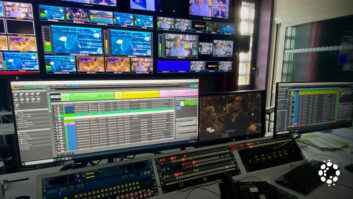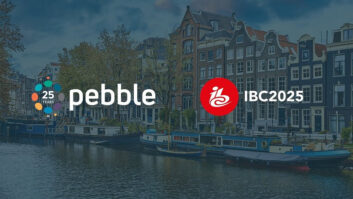
Pebble Beach Systems has announced the launch of a new automated render solution called Marlin. The new system reduces dependence on dedicated 3D playout graphics hardware and minimises processing overheads for channel in a box solutions.
Originally shown in conjunction with an Adobe After Effects 3D graphics plug-in, Marlin (Marina Advanced Render List Interface) is a pre-render workflow tool available both for the Marina automation solution and for Pebble Beach Systems’ Stingray channel in a box product. Designed to work with any underlying video server technology, Marlin frees up playout graphics equipment by managing the 3D graphics generation in advance then reinserting it into the playlist as a clip.
Pebble Beach managing director Peter Hajittofi said, “Many on-air playback systems still incorporate discrete devices which can play out complex 3D graphics promos in realtime. Where graphics are required over live sources or where schedule changes need to be made right up to the last moment, these devices may still be required and can be controlled by our Marina automation platform. However, for most broadcasters, there are benefits in rendering the graphics in advance using standard IT hardware that can serve many channels. This avoids the need for expensive 3D graphics devices in each transmission chain and provides significant savings.”
Marlin interrogates the Marina or Stingray playlist for events requiring complex graphics and generates render requests where the graphic has not already been created. This information is sent to the render engine, along with the appropriate graphics project, and a new graphic is generated.
At IBC Marlin’s 3D graphics generation workflow is demonstrated using Adobe After Effects. Marlin automatically moves the finished files to the chosen playout device, generated in a format compatible with an existing video server, or with new generation channel in a box devices. The graphics are then played out at the appropriate time as standard video files.
Marlin’s features also include the ability to determine how far ahead the playlist is interrogated in order to optimise when jobs are processed relative to the likelihood of late changes. Render jobs are prioritised by earliest on air time and are dynamically updated across all channels. Any late changes are automatically resubmitted, with Marlin evaluating whether there is time to run the render job. If it is too close to air to commit to the 3D render, the job will automatically be reallocated as a 2D render.
Peter Hajittofi continues, “The Marlin workflow avoids the potential for integrated channel devices to be overloaded during playout, meaning that more channels can be handled at the same time on each box, significantly reducing costs and saving space and power. Many 3D graphics projects are currently originated using Adobe After Effects tools, and so the implementation of this new Marlin workflow can lead to significant simplification in the graphics production workflow where live 3D graphics are not a requirement. We believe that the functionality which Marlin offers makes it the most complete graphics generation framework on the market. “






